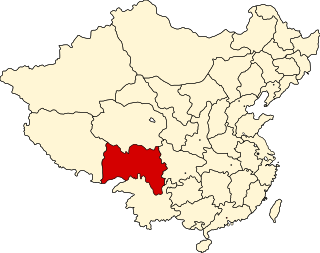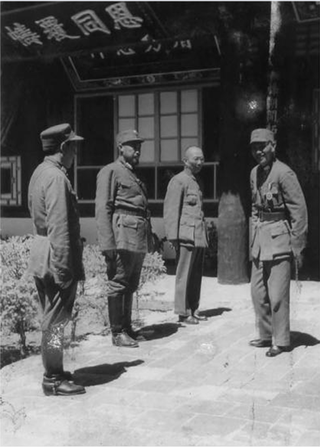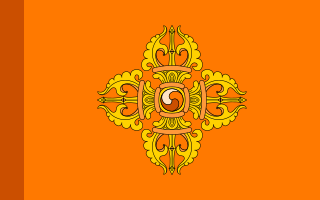Related Research Articles

In anthropology, pygmy peoples are ethnic groups whose average height is unusually short. The term pygmyism is used to describe the phenotype of endemic short stature for populations in which adult men are on average less than 150 cm tall.

Hkakabo Razi is believed to be Myanmar's highest mountain. The 5,881-meter (19,295 ft)-tall mountain is the highest mountain in Southeast Asia as well. It is located in the northern Myanmar state of Kachin in an outlying subrange of the Greater Himalayan mountain system near the border tripoint with India and China. Its highest status has recently been challenged by 5,870-meter (19,260 ft)-tall Gamlang Razi, located about 6.6 kilometers (4.1 mi) WSW on the Chinese border.

Kham is one of the three traditional Tibetan regions, the others being Domey also known as Amdo in the northeast, and Ü-Tsang in central Tibet. The official name of this Tibetan region/province is Dotoe. The original residents of Kham are called Khampas, and were governed locally by chieftains and monasteries. Kham covers a land area distributed in multiple province-level administrative divisions in present-day China, most of it in Tibet Autonomous Region and Sichuan, with smaller portions located within Qinghai and Yunnan.

Xikang was a nominal province formed by the Republic of China in 1939 on the initiative of prominent Sichuan warlord Liu Wenhui and retained by the early People's Republic of China. The former territory of Xikang is now divided between the Tibet Autonomous Region and Sichuan province.

Chushi Gangdruk was a Tibetan guerrilla group. Formally organized on 16 June 1958, the Chushi Gangdruk fought the forces of the People's Republic of China (PRC) from 1956 until 1974 when the Central Intelligence Agency (CIA) withdrew its support for the guerrilla group.
The Taron or T’rung are an ethnic group in the Himalayan foothills of northern Kachin State, Myanmar, whose population is declining to the point where they may disappear entirely. They have been referred to as the "East Asian pygmies". They are allegedly descended from an ethnic group concentrated in China known as Derung who migrated to Burma from Tibet in the 1880s.

Kampa or Kamba Dzong, (Gampa Dzong in Standard Tibetan, and Gangba Xian in Chinese) is a Tibetan town north of Sikkim. It is the headequarters Kamba County in the Shigatse Prefecture. It is marked by an iconic hill-top fort, much admired by the expeditions travelling to Mount Everest during the early 20th century. It also used to be a border trading post for Sikkimese traders from North Sikkim, prior to the Chinese annexation of Tibet.

The 1959 Tibetan uprising began on 10 March 1959, when a revolt erupted in Lhasa, the capital of Tibet, which had been under the effective control of the People's Republic of China (PRC) since the Seventeen Point Agreement was reached in 1951. The initial uprising occurred amid general Chinese-Tibetan tensions and a context of confusion, because Tibetan protesters feared that the Chinese government might arrest the 14th Dalai Lama. The protests were also fueled by anti-Chinese sentiment and separatism. At first, the uprising mostly consisted of peaceful protests, but clashes quickly erupted and the Chinese People's Liberation Army (PLA) eventually used force to quell the protests. Some of the protesters had captured arms. The last stages of the uprising included heavy fighting, with high civilian and military losses. The 14th Dalai Lama escaped from Lhasa, while the city was fully retaken by Chinese security forces on 23 March 1959. Thousands of Tibetans were killed during the 1959 uprising, but the exact number of deaths is disputed.
Tibetan literature generally refers to literature written in the Tibetan language or arising out of Tibetan culture. Historically, Tibetan has served as a trans-regional literary language that has been used, at different times, from Tibet to Mongolia, Russia, and present-day Bhutan, Nepal, India, and Pakistan. Today, the term Tibetan literature can also be applied to any work by an ethnic Tibetan person or arising out of Tibetan folk culture; contemporary Tibetan writers sometimes use Chinese, English, or other languages to compose their work.
Tenzin Jigme (Thutob Wangchuk) (Lhasa, 1948 – February 13, 1997) was a Tibetan tulku and the sixth Reting Rinpoche.

The Ma clique fought a series of military campaigns between 1917 and 1949 against unconquered Amchok and Ngolok (Golok) tribal Tibetan areas of Qinghai (Amdo), undertaken by two Hui commanders, Gen. Ma Qi and Gen. Ma Bufang, on behalf of the Beiyang and Kuomintang governments of the Republic of China. The campaigns lasted between 1917 and 1949. The conflict was spurred by multiple factors, notably for economic and socio-political reasons rather than by any racial or religious enmity.

George Neilson Patterson also known as Khampa Gyau and Patterson of Tibet, was a Scottish engineer and missionary who served as medical officer and diplomatic representative of the Tibetan resistance movement during the Annexation of Tibet by the People's Republic of China.

The Battle of Chamdo occurred from 6 to 24 October 1950. It was a military campaign by the People's Republic of China (PRC) to take the Chamdo Region from a de facto independent Tibetan state. The campaign resulted in the capture of Chamdo and the annexation of Tibet by the People's Republic of China.
The Batang uprising was an uprising by the Khampas of Kham against the assertion of authority by Qing China.

The Tibet Improvement Party was a nationalist, revolutionary, anti-feudal and pro-Republic of China political party in Tibet. It was affiliated with the Kuomintang and was supported by mostly Khampas, with the Pandatsang family playing a key role.

Pandatsang Rapga was a Khampa revolutionary during the first half of the 20th century in Tibet. He was pro-Kuomintang and pro-Republic of China, anti-feudal, anti-communist. He believed in overthrowing the Dalai Lama's feudal regime and driving British imperialism out of Tibet, and acted on behalf of Chiang Kai-shek in countering the Dalai Lama. He was later involved in rebelling against communist rule.

The Tibetan Army was the armed forces of Tibet from 1913 to 1959. It was established by the 13th Dalai Lama shortly after he proclaimed the independence of Tibet in 1912, and was modernised with the assistance of British training and equipment. It was dissolved by the Chinese government following the failed 1959 Tibetan uprising.

Majnu-ka-tilla (MT) is a colony in Delhi, India that was established around 1950. Majnu-ka-tilla is officially called New Aruna Nagar Colony, Chungtown, and Samyeling. It is part of North Delhi district and is located at the bank of the Yamuna River (NH-1) near ISBT Kashmiri Gate.
Max Gordon Oidtmann is an American historian of Late Imperial China (1368–1912) and Inner Asia. He also has interest in modern China and the affairs of Chinese ethnic minorities. He was an assistant professor at Georgetown University in Qatar from 2013 to 2021. Oidtmann is currently a faculty member at the Institute for Sinology at Ludwig Maximilian University of Munich in Germany.
The Khampa Disarming Operation is a military action to disarm Tibetian rebels who were operating in Nepal after Dalai Lama fled to India under Chinese security action in Tibet in 1959. Lieutenant Colonel Satchit Samser Rana was in charge of the mission from the Nepal Army in this operation.